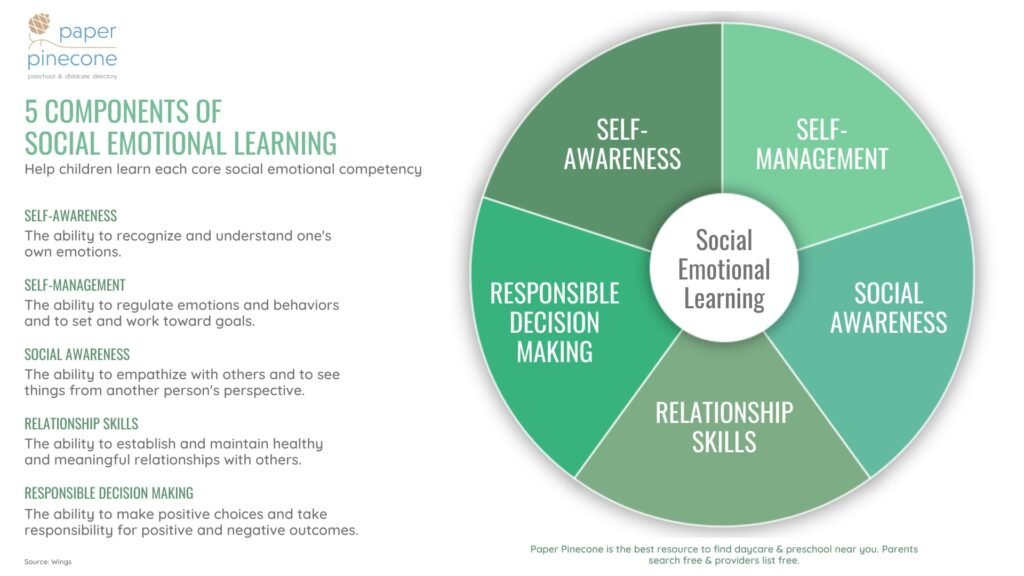Social-Emotional Learning (SEL) An educational framework called social-emotional learning (SEL) places a strong emphasis on the growth of emotional intelligence. The educational community has come to recognize the significance of social and emotional learning (SEL) in recent years due to research demonstrating the crucial role that social and emotional competences play in both academic performance and general well-being.

Understanding Social-Emotional Learning
Self-awareness, self-management, social awareness, interpersonal skills, and responsible decision-making are the five fundamental characteristics of SEL. These abilities are critical for both personal growth and for fostering a supportive learning environment in the classroom.
The Benefits of SEL
Numerous research demonstrate SEL’s advantages for academic success. Pupils that take part in SEL programs frequently exhibit increased involvement in the classroom, better academic achievement, and improved problem-solving abilities. Additionally, SEL has a strong connection to mental health, supporting students’ resilience and lowering their levels of anxiety and sadness.
Implementing SEL in Schools
Planning and implementing SEL integration into school curricula requires careful thought. Teachers can use pre-existing curriculum or specialized programs to improve social-emotional learning to include social-emotional learning (SEL). To guarantee that they have the tools necessary to effectively teach and model SEL abilities, professional development is crucial for educators.

SEL Strategies and Practices
Engaging classroom activities like role-playing, group discussions, and cooperative projects are examples of effective SEL practices. These activities allow children to learn empathy, communication, and dispute resolution.
Mindfulness and self-regulation strategies are significant tools in SEL. By fostering self-awareness and emotional regulation, these activities help students overcome obstacles more skillfully.
Challenges and Considerations
Even with its advantages, SEL implementation in schools can present difficulties. A lack of resources, inadequate training for teachers, and reluctance to change within school cultures can all be obstacles. Furthermore, in order to guarantee that SEL programs fulfill the various needs of every student, it is critical to take cultural responsiveness into account.

Case Studies and Success Stories
For example, a case study of a middle school that used SEL revealed notable gains in the conduct and academic achievement of the students. Student and teacher testimonials highlight the transformative potential of SEL in creating a supportive learning environment.

Conclusion
In conclusion, social-emotional learning is essential to developing competent, well-rounded children who are ready for the difficulties of life after school. Teachers, legislators, and communities can cultivate a generation of resilient, compassionate people who are prepared for both academic and personal success by placing a high priority on SEL.
FAQs
What is Social-Emotional Learning (SEL)?
SEL is a process that teaches people how to recognize and control their emotions, make responsible decisions, set constructive objectives, and demonstrate empathy for others. It includes the following five fundamental competencies: relational skills, social awareness, self-management, self-awareness, and responsible decision-making.
Why is SEL important in education?
SEL is important because it fosters social and emotional intelligence in pupils, which enhances academic achievement, improves mental health, and lessens behavioral problems. It helps pupils succeed in life and cultivates a pleasant school climate.
How does SEL benefit academic performance?
Empirical studies suggest that pupils possessing robust social-emotional abilities typically exhibit elevated academic performance, enhanced attendance, and heightened school involvement. SEL aids in the development of traits that support academic performance in students, such as persistence, drive, and concentration.
Can SEL programs be integrated into existing curricula?
Yes, SEL can be easily incorporated into current classroom activities and lessons in a variety of subject areas. Teachers can apply SEL practices in a variety of ways, including group projects, conversations, and classes that are specifically focused on SEL.
What challenges might schools face when implementing SEL?
A few common problems are a lack of funding, inadequate training for teachers, opposition to change in school cultures, and measurement issues with SEL initiatives.



